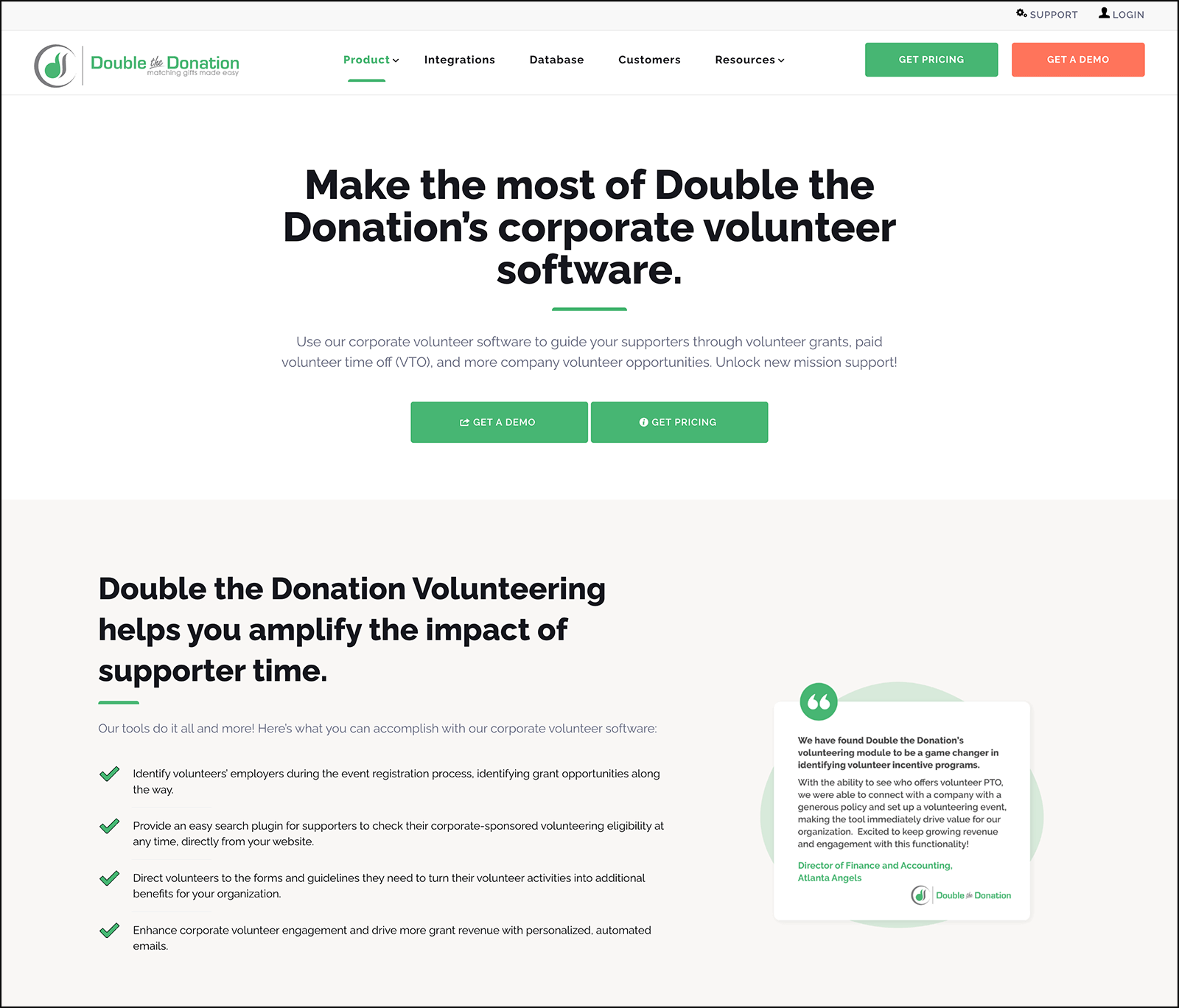Volunteer Management Training: Top Resources to Build Skills
If your organization relies on volunteers to further its mission, managing them effectively should be a top priority for your team. However, you may...
8 min read
 Timothy Sarazen
Feb 25, 2025 4:23:36 PM
Timothy Sarazen
Feb 25, 2025 4:23:36 PM
.png)
Volunteers are the lifeblood of many nonprofit organizations. By dedicating their time, energy, and skills, these individuals help nonprofits fulfill their missions and amplify their impact in local communities. Effectively managing these dedicated supporters ensures they have a positive experience, remain engaged, and continue contributing to your cause over the long term.
However, as your volunteer base grows, efficiently coordinating schedules, onboarding new helpers, and tracking hours can quickly become overwhelming. Investing in the right tools can streamline your volunteer program, freeing up time to focus on your mission.
In this guide, you’ll learn all you need to know about volunteer management software, including:
Ready to learn more about volunteer management tools? Let’s get started by exploring what volunteer management software is and why it’s so useful.
Volunteer management software describes dedicated platforms designed to help nonprofits and other organizations effectively coordinate, track, and engage their volunteer base. While many organizations start off using basic spreadsheets and manual processes for volunteer coordination, investing in a dedicated tool is more efficient and scalable as your program grows.
By centralizing volunteer data, scheduling, communication, and reporting in one place, volunteer management software ensures nonprofits can spend more time delivering impact and less time on administrative tasks.
By leveraging a volunteer management platform, your nonprofit can experience various benefits, such as:
.png?width=940&height=470&name=volunteer%20management%20software_benefits%20(1).png)
A good volunteer management platform helps you save time, reduce stress, and accomplish more for your mission.
To truly maximize the potential of your volunteer program and streamline operations, it's essential to not only understand the benefits of volunteer management software but also use them to make a compelling case to your nonprofit’s leadership. Whether you’re seeking to enhance volunteer retention, improve scheduling, or better manage data, leadership buy-in is crucial to ensuring your organization sees the software as a valuable investment.
Not all platforms are equally effective or suited to your nonprofit’s specific needs, so the tools you’ll prioritize will be unique to your organization. However, some general features to look for include:
.png?width=940&height=806&name=volunteer%20management%20software_features%20(1).png)
Additionally, consider user-friendliness, customization options, and the level of technical support each platform offers. These factors will help you find the best fit for your organization’s unique volunteer management needs.
Below, we’ve compiled our top volunteer management software solutions. Feel free to skim through the overview table or scroll to read more details about each platform.

Better Impact offers a comprehensive volunteer management software, Volunteer Impact, that is designed for nonprofits of all sizes. With an intuitive interface, customizable features, and top-tier customer support, Volunteer Impact makes it easy to engage volunteers, track their activities, and generate useful reports.
Nonprofits choose Better Impact for its user-friendly design, robust capabilities, and flexible pricing options. Organizations of all sizes—whether they have a few dozen or a few thousand volunteers—can tailor the system to meet their needs.
But don’t just take our word for it—explore real-life case studies to see how other nonprofits have strengthened their volunteer programs using Better Impact. From small community groups to larger, more complex organizations, these success stories demonstrate how the right volunteer management platform can drive greater impact.

VolunteerHub helps nonprofits manage, recruit, and engage their volunteers with intuitive scheduling, communication, and reporting tools. It’s widely used across various sectors, including healthcare, education, and animal welfare.
VolunteerHub offers tiered plans based on your organization’s size and needs. Contact the VolunteerHub team for specific pricing information or request a demo on their website.

VolunteerMatters is a solution designed to streamline volunteer coordination for nonprofits, schools, and government entities. Its robust feature set supports compliance tracking, background checks, and more.
Pricing for VolunteerMatters varies depending on the number of volunteers and specific functionality needed. Contact the VolunteerMatters sales team for a customized quote.

Civic Champs focuses on simplifying volunteer engagement through mobile and web-based platforms. Their intuitive app helps nonprofits build strong relationships with volunteers, track hours, and gather feedback on the go.
Civic Champs offers different pricing tiers for nonprofits of all sizes. To get accurate, up-to-date cost information, request pricing details from their team.

Golden stands out with its modern, user-friendly design and focus on community engagement. The platform provides nonprofits with the tools to recruit and retain volunteers through meaningful experiences.
After a 30-day free trial, Golden’s pricing plans start at $1,200/year. Contact the Golden team for more details on which plan suits your needs.

POINT is designed to make volunteering easy and accessible. With user-friendly mobile features, it connects volunteers to events and allows nonprofits to manage and report on volunteer activities.
POINT offers various pricing tiers, including a free plan for small organizations. For more advanced features, contact the POINT team or visit their pricing page for details.

PlanHero is known for its easy-to-use event and volunteer scheduling tools. It’s particularly popular with churches, schools, and community-based nonprofits looking for a quick scheduling solution.
PlanHero’s plans begin at $49/year for basic scheduling tools. More advanced features are available on higher-tier plans.

Volunteer Local offers simple but powerful volunteer registration and scheduling tools. It’s especially popular for large events and festivals that require hundreds or thousands of volunteers.
Volunteer Local’s pricing starts with a free “Community” plan that allows you to manage a limited number of events. Paid plans offer increased capacity and advanced features—check their pricing page for details.

VolunteerMark is a flexible platform focusing on volunteer scheduling, management, and donor integration. It helps nonprofits engage volunteers and donors in a single, unified database.
VolunteerMark offers a free plan for small nonprofits, but paid plans unlock expanded functionality. For specific pricing, contact the VolunteerMark team.

CERVIS is designed to manage volunteer engagement, track service hours, and streamline event planning. It works well for nonprofits, schools, and faith-based organizations looking for robust program tracking.
CERVIS offers different packages based on the number of administrators and active volunteers. Contact their team for exact pricing information.

Volunteers for Salesforce is a volunteer coordination app built on the Salesforce platform. It helps nonprofits manage volunteer sign-ups, track hours, and run reports directly within Salesforce.
Volunteers for Salesforce is a free add-on for qualifying nonprofits using Salesforce Nonprofit Cloud. Contact Salesforce for more details on nonprofit discounts.

Shift provides a straightforward solution for managing volunteer shifts, tasks, and roles. Organizations can easily create a variety of volunteer opportunities and oversee them from one dashboard.
Shift’s pricing is based on the size of your volunteer program. For specific packages, contact the Shift team to learn more.

SignUp.com offers simple online sign-up sheets for volunteer events, fundraisers, and group activities. It’s used by nonprofits, schools, and community groups looking for an intuitive way to coordinate tasks.
SignUp.com offers a free basic plan and paid options that unlock advanced features like custom branding and analytics. Check their website for plan comparisons.

SignUpGenius is a popular volunteer sign-up tool known for its ease of use. It’s highly flexible, letting nonprofits customize sign-up forms and manage multiple volunteer activities.
SignUpGenius offers a free version supported by ads. Their paid plans (starting at $8.99/month) remove ads and provide additional customization and functionality.

Mobilize is designed for advocacy groups, political campaigns, and nonprofits with a focus on volunteer recruitment and event management. It helps organizations coordinate large-scale volunteer movements efficiently.
Mobilize offers customized pricing based on each organization’s needs. Contact the Mobilize team for more information.

Bonterra Volunteer Management focuses on community engagement and simplifying volunteer management for nonprofits and public institutions.
To receive a detailed quote tailored to your organization, get in touch with Bonterra’s sales team.

Bloomerang Volunteer (part of Bloomerang’s integrated CRM system) helps nonprofits consolidate donor and volunteer data in one database, offering a holistic view of their supporter network.
Bloomerang Volunteer pricing is available upon request, as it typically comes bundled with Bloomerang’s overall fundraising software.

Double the Donation is best known for matching gift software, but they also provide solutions for managing volunteer grants and corporate volunteering. This platform helps nonprofits tap into volunteerism initiatives offered by businesses.
Double the Donation’s volunteer and matching gift tools are custom-priced based on usage. Contact the team or visit their pricing page for detailed plan options.
Choosing the right volunteer management software can make all the difference in your organization’s efficiency, volunteer satisfaction, and overall impact. By streamlining the recruitment, scheduling, and engagement processes, you’ll free up valuable time and energy to invest back into your mission.
For more information on volunteer management, check out these resources:
Featured Posts
.png)
If your organization relies on volunteers to further its mission, managing them effectively should be a top priority for your team. However, you may...

The many moving parts of nonprofit events—from planning your event agenda and gathering auction items to coordinating with caterers and designing...

Chances are, your nonprofit already recruits volunteers to help run your events, but have you ever thought about how you’re allocating their time?